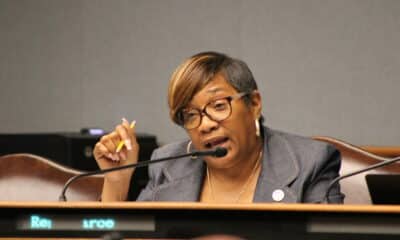Mississippi Today
Inside the four-hour U.S. House hearing on welfare reform featuring Brett Favre

WASHINGTON — Minutes before the U.S. House Committee on Ways and Means held a hearing Tuesday on the topic of the Temporary Assistance for Needy Families, the subject of a still unfolding scandal in Mississippi, Chairman Rep. Jason Smith huddled with his colleagues.
The other congressmen wanted to know why the chairman had invited former NFL quarterback Brett Favre — who is facing civil charges for his alleged role in diverting TANF funds to a volleyball stadium and a pharmaceutical startup — to testify.
Then, Smith revealed, one of the congressmen asked a question that underscored the larger problem: “What is TANF?”
Temporary Assistance for Needy Families is a $16 billion-a-year federal block grant administered by states to address poverty. While it is known for providing cash assistance, known as the welfare check, to low-income families, states have been spending the vast majority of the money in other ways, “including some with tenuous connections to a TANF purpose,” the federal agency that oversees the funds recently concluded.
The unnamed lawmaker is about four years late to the game.
Favre said he learned what TANF was in 2020, when Mississippi State Auditor Shad White released an audit naming Favre as one of the improper recipients of an estimated $94 million in misused funds.
“Now I know, TANF is one of our country’s most important welfare programs to help people in need,” Favre told members of House Ways and Means, the budgeting committee responsible for revenue-related legislation within the nation’s social safety net programs. “Importantly, I have learned that nobody was — or is — watching how TANF funds are spent.”
Smith said he invited Favre to testify about rampant abuse in the program, which ensnared the athlete in a reputation-marring scandal, as part of a conversation about how to transform TANF to reach needy families and move people into work. Tuesday’s hearing, which lasted more than four hours, followed a subcommittee of Ways and Means held a similar hearing more than a year ago.
But four years after the original audit, Mississippians have more to learn about how the misspending occurred, who all was responsible and how the government plans to hold them accountable. A federal criminal investigation quietly drags on as seven people who pleaded guilty await prison sentencing; a slow-moving state civil lawsuit against Favre and three dozen others gags defendants and their attorneys from speaking publicly about the case; and the federal human service agency has yet to enact meaningful guardrails around the program.
A report that the committee requested last year, and was released Tuesday, found that accounting deficiencies within the TANF program occur in all 50 states and little is done to correct them.
The committee heard Tuesday from a beneficiary of Missouri’s TANF work program, Matt Underhile, a corrections officer and father of seven children.
Underhile was in his early 40s when he took action to turn his life around after nearly two decades of drug abuse and unstable employment. He learned about the state’s TANF-funded work program called the Missouri Excel Center on Facebook. Through it, he received transportation assistance to get to and from class and earned his high school diploma. He said the program offered to pay for things like steel-toe boots or scrubs to help people succeed at work.
He said the program taught him “that there is always a way to remove any barrier you may have; that there are people and programs out there that care and can help you.”
But Mississippi’s TANF program hardly works this way. In 2022, the cash assistance program — no more than $260 a month for a family of three — served just 291 adults. Of those, fewer than 1% were employed, according to federal data.
TANF is supposed to be a work program, but Mississippi imposes such strict eligibility requirements and such harsh sanctions — such as taking away a person’s food benefits — that low-income Mississippians are scared to apply, said Jarvis Dortch, director of the ACLU of Mississippi.
When the state has contracted with outside agencies to provide work training like Underhile described, it has not produced reports to say what the programs offered or who they served.
The largest subrecipients of non-assistance funds are not workforce training agencies, but organizations that work with children — the child abuse and neglect investigations department, the Boys & Girls Club, a children’s mental health organization and a global humanitarian nonprofit.
“Mississippi continues to spend little on direct cash assistance while continuing to provide TANF dollars to unaccountable third parties,” Dortch said in his testimony on Tuesday.
The federal government gathers little information about how states choose to use their TANF grants, except for periodic reporting of how they divvy up the money among several vague categories — basic assistance, child welfare services, work, education or training activities, work supports, child care out of wedlock pregnancy prevention, fatherhood and two-parent family formation and maintenance programs, etc.
Mississippi consistently spends a much greater share of its TANF grant on “work, education and training activities” than most states — 40% in 2022. With that statistic, Mississippi’s TANF program might seem as if it’s prioritizing solutions to generational poverty.
“Sounds good until you look under the hood,” Dortch said.
A closer look shows that roughly 80% of that spending is on a college scholarship program serving many middle-class families, Mississippi Today first reported in 2019.
Dortch offered an alternative: More child care funding for working parents. Mississippi is allowed to transfer up to 30% of its TANF funding to the existing Child Care Development Fund to provide vouchers to more families, though it hasn’t opted to do this in recent years. Dortch also pointed to the success of Magnolia Mother’s Trust universal basic income program created by Jackson-based Springboard to Opportunity.
“People that get cash assistance … they’re able to get the space to breathe to be able to do things like apply to go to school, look for other jobs, they aren’t so pressured in life by trying to make ends meet,” Dortch said.
In Mississippi, $5 million of the spending that it labeled work activities, work supports or fatherhood programs was actually the construction of a new volleyball stadium.
In 2017, Favre started lobbying for money from a nonprofit funded almost entirely by TANF funds to build a volleyball stadium at his alma mater, University of Southern Mississippi. The nonprofit founder, Nancy New, informed him that federal restrictions prevented her from using the money on construction projects. But, they thought, if they called the facility a “Wellness Center,” and included classrooms where the nonprofit could ostensibly hold classes for needy parents, the nonprofit could provide the funding through a $5 million upfront lease of the property.
Lawyers hired by the state welfare department in 2022 filed civil charges against the university’s athletic foundation and seven people they say are responsible for this sham, including Favre. New is awaiting sentencing on state charges for her role in the overarching scheme.
U.S. Rep. Adrian Smith, R-Nebraska, asked Favre on Tuesday how officials characterized the source of the funding he was seeking. Favre said it was his understanding that they were grants.
“Never was TANF or welfare funds mentioned in any conversations,” Favre said.
“Were public funds mentioned?” Adrian Smith asked, and Favre didn’t immediately respond. “Was it your understanding that it was private funds from a wealthy individual or some source?”
“I don’t recall. I just remember that grant money,” Favre said.
Favre and New also arranged an additional $1.1 million payment in exchange for Favre to record a radio ad promoting the welfare program, which aired the following year.
“If you were to pay me is there anyway the media can find out where it came from and how much?” Favre once texted the nonprofit operator.
U.S. Rep. Linda Sanchez, D-California, enlarged and printed the text message on a display board that she brought to the hearing. Favre returned those funds to the state in 2020 and 2021.
After Favre secured the funds for the initial groundbreaking on the volleyball stadium, he returned to New for an additional investment in a startup pharmaceutical venture claiming it was going to produce a drug to treat concussions — an injury with which Favre was familiar. The project received over $2 million in welfare funds, but no drug was developed.
“Sadly, I also lost my investment in a company that I believed was developing a breakthrough concussion drug I thought would help others,” Favre said in his testimony. “As I’m sure you’ll understand, while it’s too late for me — I’ve recently been diagnosed with Parkinson’s — this is also a cause dear to my heart.”
The founder of the company, Jake Vanlandingham, pleaded guilty within the ongoing federal probe in July. The revelation of Favre’s Parkinson’s diagnosis made national headlines before the TANF hearing concluded.
Testimony from Sam Adolphsen, policy director for the conservative think tank Foundation for Government Accountability, challenged whether states should be entirely to blame for TANF misspending.
When Adolphsen served as the chief operating officer of the Maine Department of Health and Human Services, he said his agency exercised policy that allows states to transfer TANF funds to another federal program, the Social Services Block Grant, which involved home-based services for seniors and people with disabilities, domestic violence support centers, transportation, and other services.
This resulted in a similar comingling of funds that got Mississippi officials in trouble.
Adolphsen said in his written testimony that Maine officials sought guidance from the federal agency that administers the funds, the U.S. Department of Health and Human Services, “with often unclear communications from the officials.” Maine auditors eventually raised concerns about some of this transfer spending and the state reversed the expenditures.
In Mississippi, at least one defendant in the ongoing civil case has said that federal welfare officials were present in the planning of programs that auditors later found unlawful.
“More work can be done in federal law to provide states with more clarity on the flexibility of these transfers in advance of such expenditures,” Adolphsen said in his testimony.
Adolphsen’s organization, FGA, lauded Mississippi for policies it enacted during the scandal, including the HOPE Act — a law that imposed some of the strictest eligibility requirements in the nation, creating a maze of bureaucratic red tape that current Mississippi Department of Human Services Director Bob Anderson said burdens the department and should be repealed.
Last year, the House Ways and Means Committee requested that the Government Accountability Office conduct a nationwide review of non-cash TANF spending, which is where 78% of the funds go. The committee wanted to know, among other things, how states track the performance of their non-assistance programs, how they ensure they are submitting accurate financial reports, and what the federal government does with the annual TANF audit findings it receives.
The report, released in conjunction with the hearing, shows that from 2021-2023, all 50 states had unresolved audit findings in their TANF programs, 50 of which were “severe” and the majority of which were repeated findings from previous years.
Before the Mississippi welfare scandal became known, these audit deficiencies proved to be a warning sign of the larger program breakdown.
West Virginia has recorded an accounting deficiency for 15 years. Thirty-one of the 155 findings contained questioned costs, like the ones cited in Mississippi’s widely publicized 2019 audit. One state’s questioned costs involved over $107 million and repeated for two years.
As for how the federal government follows up on these unresolved findings, the Government Accountability Office didn’t have an answer, but said that it would examine this process in its ongoing work.
Movement in the civil case against Favre and roughly three dozen other people or companies — which attempts to claw back an implausible $80 million in misspending — picked up the day before Favre’s testimony.
On Monday, Favre’s lawyers fired off 10 new subpoenas requiring depositions from the state auditor’s office, deputy state auditor Stephanie Palmertree, the attorney general’s office, the lieutenant governor’s office, Gov. Tate Reeves, former Reeves chief of staff Brad White, former First Lady Deborah Bryant, and three individual Mississippi Department of Human Services employees.
At the hearing, Favre predictably threw shade at State Auditor Shad White, the state official who launched the initial investigation into welfare spending and has since written a book about the ordeal with Favre’s name in the subtitle. The athlete is currently suing White for defamation.
Favre called White “an ambitious public official who decided to tarnish my reputation to try to advance his own political career.”
White wrote a letter to the Ways and Means committee Monday evening in an effort to preempt any negative impression Favre may give of him. White included photos of Favre’s text messages to remind lawmakers of the athlete’s interest in keeping the payments confidential.
Favre also questioned the current leadership of the state welfare agency, which has paid Jones Walker law firm nearly $1.5 million in TANF funds to bring the ongoing civil action.
“Those same lawyers, before they sued me, came to my home town to try to convince me to retain them in this very dispute,” Favre said.
University of Southern Mississippi attempted to resolve the claims against it by setting up a scholarship program for TANF-eligible students, Favre said, but the plaintiff rejected the settlement, which “would have shut off the spigot of TANF funds to the lawyers.”
Back to the original question by Chairman Smith’s colleagues: What’s the purpose of inviting Favre to speak before Congress?
“If someone in Mississippi is accused of misspending $50 in SNAP benefits, that person’s life will be turned upside down. Mr. Favre’s right here and he’s accused of misspending a million dollars and he’s speaking before Congress,” Dortch told the committee. “Something is wrong.”
For years in Mississippi, state employees and politicians scrambled to please Favre when he reached out about funding for projects or requests for meetings. One of the state’s favorite and most notable sons was in their corner, and they often responded accordingly.
Similar behavior was on full display in the House committee hearing on Tuesday. When Favre entered the Longfellow Office Building hearing room, cameras clicked and attendees turned their heads to catch a glimpse of the NFL Hall of Famer.
U.S. Rep. Beth Van Duyne, R-Texas, said it seemed Favre had become a victim of his own celebrity.
Sanchez, the California representative, delivered the most aggressive questions about Favre’s involvement in the welfare scandal, to which U.S. Rep. Drew Ferguson, R-Georgia, responded, “Unlike my colleague, I’m not mad at you about much, but I am mad that you couldn’t stay with the Atlanta Falcons.”
This article first appeared on Mississippi Today and is republished here under a Creative Commons license.![]()
Mississippi Today
If Tate Reeves calls a tax cut special session, Senate has the option to do nothing

An illness is spreading through the Mississippi Capitol: special session fever.
Speculation is rampant that Gov. Tate Reeves will call a special session if the Senate does not acquiesce to his and the House leadership’s wishes to eliminate the state personal income tax.
Reeves and House leaders are fond of claiming that the about 30% of general fund revenue lost by eliminating the income tax can be offset by growth in other state tax revenue.
House leaders can produce fancy charts showing that the average annual 3% growth rate in state revenue collections can more than offset the revenue lost from a phase out of the income tax.
What is lost in the fancy charts is that the historical 3% growth rate in state revenue includes growth in the personal income tax, which is the second largest source of state revenue. Any growth rate will entail much less revenue if it does not include a 3% growth in the income tax, which would be eliminated if the governor and House leaders have their way. This is important because historically speaking, as state revenue grows so does the cost of providing services, from pay to state employees, to health care costs, to transportation costs, to utility costs and so on.
This does not even include the fact that historically speaking, many state entities providing services have been underfunded by the Legislature, ranging from education to health care, to law enforcement, to transportation. Again, the list goes on and on.
And don’t forget a looming $25 billion shortfall in the state’s Public Employee Retirement System that could create chaos at some point.
But should the Senate not agree to the elimination of the income tax and Reeves calls a special session, there will be tremendous pressure on the Senate leadership, particularly Lt. Gov. Delbert Hosemann, the chamber’s presiding officer.
Generally speaking, a special session will provide more advantages for the eliminate-the-income-tax crowd.
First off, it will be two against one. When the governor and one chamber of the Legislature are on the same page, it is often more difficult for the other chamber to prevail.
The Mississippi Constitution gives the governor sole authority to call a special session and set an agenda. But the Legislature does have discretion in how that agenda is carried out.
And the Legislature always has the option to do nothing during the special session. Simply adjourn and go home is an option.
But the state constitution also says if one chamber is in session, the other house cannot remain out of session for more than three days.
In other words, theoretically, the House and governor working together could keep the Senate in session all year.
In theory, senators could say they are not going to yield to the governor’s wishes and adjourn the special session. But if the House remained in session, the Senate would have to come back in three days. The Senate could then adjourn again, but be forced to come back if the House stubbornly remained in session.
The process could continue all year.
But in the real world, there does not appear to be a mechanism — constitutionally speaking — to force the Senate to come back. The Mississippi Constitution does say members can be “compelled” to attend a session in order to have a quorum, but many experts say that language would not be relevant to make an entire chamber return to session after members had voted to adjourn.
In the past, one chamber has failed to return to the Capitol and suffered no consequences after the other remained in session for more than three days.
As a side note, the Mississippi Constitution does give the governor the authority to end a special session should the two chambers not agree on adjournment. In the early 2000s, then-Gov. Ronnie Musgrove ended a special session when the House and Senate could not agree on a plan to redraw the state’s U.S. House districts to adhere to population shifts found by the U.S. Census.
But would Reeves want to end the special session without approval of his cherished income tax elimination plan?
Probably not.
In 2002 there famously was an 82-day special session to consider proposals to provide businesses more protection from lawsuits. No effort was made to adjourn that session. It just dragged on until the House finally agreed to a significant portion of the Senate plan to provide more lawsuit protection.
In 1969, a special session lasted most of the summer when the Legislature finally agreed to a proposal of then-Gov. John Bell Williams to opt into the federal Medicaid program.
In both those instances, those wanting something passed — Medicaid in the 1960s and lawsuit protections in the 2000s — finally prevailed.
This article first appeared on Mississippi Today and is republished here under a Creative Commons license.![]()
Mississippi Today
On this day in 1898

Feb. 22, 1898

Frazier Baker, the first Black postmaster of the small town of Lake City, South Carolina, and his baby daughter, Julia, were killed, and his wife and three other daughters were injured when a lynch mob attacked.
When President William McKinley appointed Baker the previous year, local whites began to attack Baker’s abilities. Postal inspectors determined the accusations were unfounded, but that didn’t halt those determined to destroy him.
Hundreds of whites set fire to the post office, where the Bakers lived, and reportedly fired up to 100 bullets into their home. Outraged citizens in town wrote a resolution describing the attack and 25 years of “lawlessness” and “bloody butchery” in the area.
Crusading journalist Ida B. Wells wrote the White House about the attack, noting that the family was now in the Black hospital in Charleston “and when they recover sufficiently to be discharged, they) have no dollar with which to buy food, shelter or raiment.
McKinley ordered an investigation that led to charges against 13 men, but no one was ever convicted. The family left South Carolina for Boston, and later that year, the first nationwide civil rights organization in the U.S., the National Afro-American Council, was formed.
In 2019, the Lake City post office was renamed to honor Frazier Baker.
“We, as a family, are glad that the recognition of this painful event finally happened,” his great-niece, Dr. Fostenia Baker said. “It’s long overdue.”
This article first appeared on Mississippi Today and is republished here under a Creative Commons license.![]()
Mississippi Today
Memorial Health System takes over Biloxi hospital, what will change?

by Justin Glowacki with contributions from Rasheed Ambrose, Javion Henry, McKenna Klamm, Matt Martin and Aidan Tarrant
BILOXI – On Feb. 1, Memorial Health System officially took over Merit Health Biloxi, solidifying its position as the dominant healthcare provider in the region. According to Fitch Ratings, Memorial now controls more than 85% of the local health care market.
This isn’t Memorial’s first hospital acquisition. In 2019, it took over Stone County Hospital and expanded services. Memorial considers that transition a success and expects similar results in Biloxi.
However, health care experts caution that when one provider dominates a market, it can lead to higher prices and fewer options for patients.
Expanding specialty care and services

One of the biggest benefits of the acquisition, according to Kristian Spear, the new administrator of Memorial Hospital Biloxi, will be access to Memorial’s referral network.
By joining Memorial’s network, Biloxi patients will have access to more services, over 40 specialties and over 100 clinics.
“Everything that you can get at Gulfport, you will have access to here through the referral system,” Spear said.
One of the first improvements will be the reopening of the Radiation Oncology Clinic at Cedar Lake, which previously shut down due to “availability shortages,” though hospital administration did not expand on what that entailed.
“In the next few months, the community will see a difference,” Spear said. “We’re going to bring resources here that they haven’t had.”
Beyond specialty care, Memorial is also expanding hospital services and increasing capacity. Angela Benda, director of quality and performance improvement at Memorial Hospital Biloxi, said the hospital is focused on growth.
“We’re a 153-bed hospital, and we average a census of right now about 30 to 40 a day. It’s not that much, and so, the plan is just to grow and give more services,” Benda said. “So, we’re going to expand on the fifth floor, open up more beds, more admissions, more surgeries, more provider presence, especially around the specialties like cardiology and OB-GYN and just a few others like that.”
For patient Kenneth Pritchett, a Biloxi resident for over 30 years, those changes couldn’t come soon enough.

Pritchett, who was diagnosed with congestive heart failure, received treatment at Merit Health Biloxi. He currently sees a cardiologist in Cedar Lake, a 15-minute drive on the interstate. He says having a cardiologist in Biloxi would make a difference.
“Yes, it’d be very helpful if it was closer,” Pritchett said. “That’d be right across the track instead of going on the interstate.”
Beyond specialty services and expanded capacity, Memorial is upgrading medical equipment and renovating the hospital to improve both function and appearance. As far as a timeline for these changes, Memorial said, “We are taking time to assess the needs and will make adjustments that make sense for patient care and employee workflow as time and budget allow.”
Unanswered questions: insurance and staffing
As Memorial Health System takes over Merit Health Biloxi, two major questions remain:
- Will patients still be covered under the same insurance plans?
- Will current hospital staff keep their jobs?
Insurance Concerns
Memorial has not finalized agreements with all insurance providers and has not provided a timeline for when those agreements will be in place.
In a statement, the hospital said:
“Memorial recommends that patients contact their insurance provider to get their specific coverage questions answered. However, patients should always seek to get the care they need, and Memorial will work through the financial process with the payers and the patients afterward.”
We asked Memorial Health System how the insurance agreements were handled after it acquired Stone County Hospital. They said they had “no additional input.”
What about hospital staff?
According to Spear, Merit Health Biloxi had around 500 employees.
“A lot of the employees here have worked here for many, many years. They’re very loyal. I want to continue that, and I want them to come to me when they have any concerns, questions, and I want to work with this team together,” Spear said.
She explained that there will be a 90-day transitional period where all employees are integrated into Memorial Health System’s software.
“Employees are not going to notice much of a difference. They’re still going to come to work. They’re going to do their day-to-day job. Over the next few months, we will probably do some transitioning of their computer system. But that’s not going to be right away.”
The transition to new ownership also means Memorial will evaluate how the hospital is operated and determine if changes need to be made.
“As we get it and assess the different workflows and the different policies, there will be some changes to that over time. Just it’s going to take time to get in here and figure that out.”
During this 90-day period, Erin Rosetti, Communications Manager at Memorial Health System said, “Biloxi employees in good standing will transition to Memorial at the same pay rate and equivalent job title.”
Kent Nicaud, President and CEO of Memorial Health System, said in a statement that the hospital is committed to “supporting our staff and ensuring they are aligned with the long-term vision of our health system.”
What research says about hospital consolidations
While Memorial is promising improvements, larger trends in hospital mergers raise important questions.
Research published by the Rand Corporation, a nonprofit, nonpartisan research organization, found that research into hospital consolidations reported increased prices anywhere from 3.9% to 65%, even among nonprofit hospitals.

The impact on patient care is mixed. Some studies suggest merging hospitals can streamline services and improve efficiency. Others indicate mergers reduce competition, which can drive up costs without necessarily improving care.
When asked about potential changes to the cost of care, hospital leaders declined to comment until after negations with insurance companies are finalized, but did clarify Memorial’s “prices are set.”
“We have a proven record of being able to go into institutions and transform them,” said Angie Juzang, Vice President of Marketing and Community Relations at Memorial Health System.
When Memorial acquired Stone County Hospital, it expanded the emergency room to provide 24/7 emergency room coverage and renovated the interior.
When asked whether prices increased after the Stone County acquisition, Memorial responded:
“Our presence has expanded access to health care for everyone in Stone County and the surrounding communities. We are providing quality healthcare, regardless of a patient’s ability to pay.”
The response did not directly address whether prices went up — leaving the question unanswered.
The bigger picture: Hospital consolidations on the rise
According to health care consulting firm Kaufman Hall, hospital mergers and acquisitions are returning to pre-pandemic levels and are expected to increase through 2025.
Hospitals are seeking stronger financial partnerships to help expand services and remain stable in an uncertain health care market.

Source: Kaufman Hall M&A Review
Proponents of hospital consolidations argue mergers help hospitals operate more efficiently by:
- Sharing resources.
- Reducing overhead costs.
- Negotiating better supply pricing.
However, opponents warn few competitors in a market can:
- Reduce incentives to lower prices.
- Slow wage increases for hospital staff.
- Lessen the pressure to improve services.
Leemore Dafny, PhD, a professor at Harvard and former deputy director for health care and antitrust at the Federal Trade Commission’s Bureau of Economics, has studied hospital consolidations extensively.
In testimony before Congress, she warned: “When rivals merge, prices increase, and there’s scant evidence of improvements in the quality of care that patients receive. There is also a fair amount of evidence that quality of care decreases.”
Meanwhile, an American Hospital Association analysis found consolidations lead to a 3.3% reduction in annual operating expenses and a 3.7% reduction in revenue per patient.
This article first appeared on Mississippi Today and is republished here under a Creative Commons license.![]()
-

 News from the South - Louisiana News Feed3 days ago
News from the South - Louisiana News Feed3 days agoJeff Landry’s budget includes cuts to Louisiana’s domestic violence shelter funding
-

 News from the South - North Carolina News Feed3 days ago
News from the South - North Carolina News Feed3 days agoBills from NC lawmakers expand gun rights, limit cellphone use
-

 News from the South - North Carolina News Feed7 days ago
News from the South - North Carolina News Feed7 days agoModest drops in some North Carolina prices under Trump | North Carolina
-

 News from the South - Arkansas News Feed7 days ago
News from the South - Arkansas News Feed7 days agoTiming out the incoming winter weather
-

 News from the South - Texas News Feed4 days ago
News from the South - Texas News Feed4 days agoICE charges Texas bakery owners with harboring immigrants
-

 News from the South - Oklahoma News Feed5 days ago
News from the South - Oklahoma News Feed5 days agoRemains of Aubrey Dameron found, family gathers in her honor
-

 News from the South - Florida News Feed7 days ago
News from the South - Florida News Feed7 days agoExpert discusses how deportations could cause labor shortages for several industries
-

 News from the South - Florida News Feed5 days ago
News from the South - Florida News Feed5 days agoTrump says AP will continue to be curtailed at White House until it changes style to Gulf of America











































